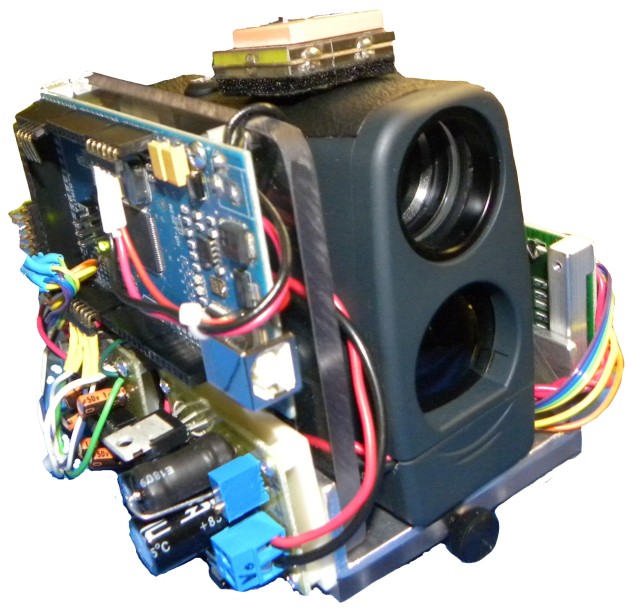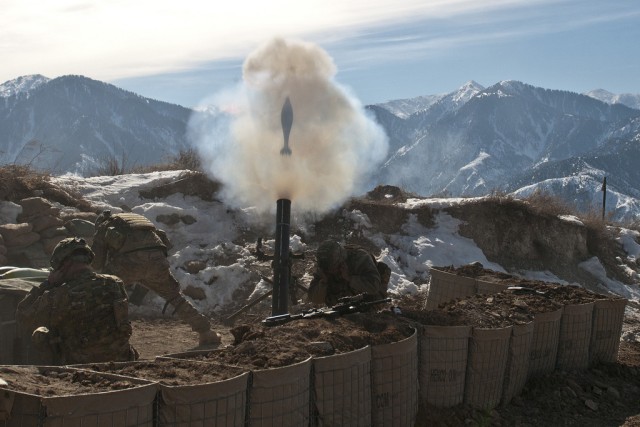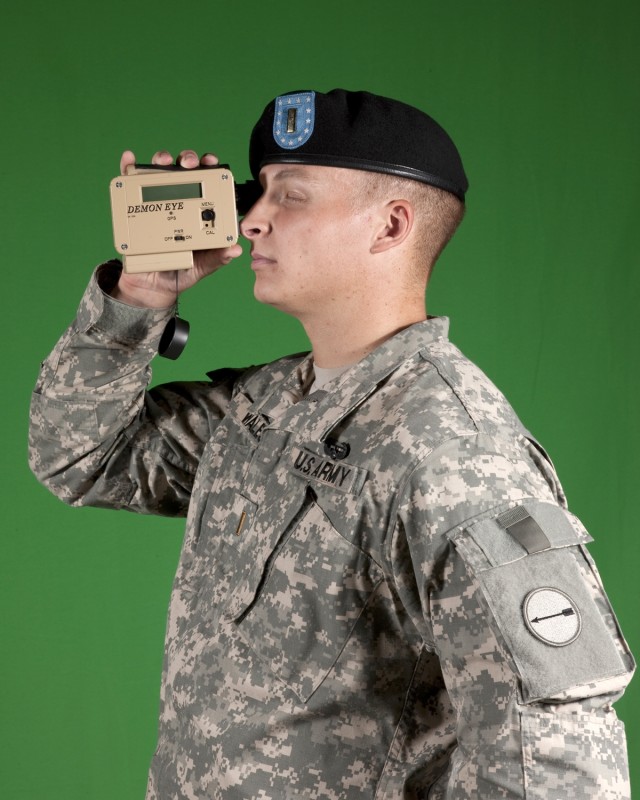DemonEye is a handheld (fits in a SAW gunners pouch) micro laser rangefinder (MLRF) for identifying targets and determining 10 digit grid coordinates with a push of a button, using an integrated laser rangefinder, GPS, optic, digital compass, microcontroller and software that is optimized for compact size and low cost of manufacture. The design and software are 100% Army owned. This article discusses both the why and how of the design coming into being and is representative of the extensive assets being applied to provide warriors with the tools to increase their effectiveness.
-----
"Making war upon insurgents is messy and slow, like eating soup with a knife" - T. E. Lawrence
-----
The COIN environment presents the warrior leader with some of the most difficult challenges they will face in their career. Operating against an enemy hidden in plain sight among the local populace while having to patrol in the rugged terrain of Afghanistan further complicates the current fight. Our enemies either strike and fade away, or when they stand and fight, do it in close proximity to civilians. They know Americans value innocent life more than they do. This creates a fight where the insurgents are free to use both direct and indirect fire weapons while coalition forces become reluctant to use indirect fire weapons when civilians are in the area. The reticence to use artillery was at least partially responsible for the deaths of five Americans who were under withering fire for hours in Kunar province at Gangjal on Sep. 8, 2009.
-----
"(A) strike can cause collateral damage that turns people against the host-nation (HN) government and provides insurgents with a major propaganda victory. Even when justified under the law of war... civilian casualties can bring media coverage that works to the insurgents' benefit." - FM 3-24 Counterinsurgency
-----
Unfortunately, this is a fact, and there is nothing we can do about it, except not miss. The U.S. Army has the best indirect fire systems, both cannon and mortar tubes, in the world. AFATDS and the MFCS allow crews to land unguided rounds within meters of targets. PGK and APMI GPS guided rounds take the accuracy even higher.
-----
The key battlefield issue is no longer the ability to destroy the target, but the capability to find it and accurately report its' location. A single soldier with a radio can now bring in practically unlimited fires. These fires will come from assets that the enemy has no practical means of fighting against, artillery and mortars miles away. The psychological effect on the enemy cannot be discounted. It changes the dynamic of the fight that they are no longer fighting just a squad. They are fighting the big guns. Being struck overwhelmingly with little to no chance of striking back leads to demoralization and reluctance to fire.
-----
"There is no logical reason why bullets or bombs should be wasted on empty air or dirt. Ideally, every shot fired should find its mark." - Col. Phillip Meilinger, Commander, USAF School of Advanced Airpower Studies
-----
This is the ultimate goal, and the tools exist to make this happen. The days of walking fire onto a target should be over. The first indication the enemy should have of being under indirect fire should be shells bursting in their positions. But this all depends on accurate target grid locations. At the company level, the attached FIST brings tools such as the GLID and DAGR to accurately locate targets for precision engagement. But our current fight isn't a company fight. It is a platoon fight, with the emphasis being on the engaged squad at the tip of the spear.
-----
"The inescapable lesson of Somalia and of other recent operations, whether humanitarian assistance, peace-keeping, or traditional warfighting, is that their outcome may hinge on decisions made by small unit leaders, and by actions taken at the lowest level." - Gen. Charles C. Krulak, Commandant, USMC
-----
The engaged squad. Led by an NCO. Smart, tough and full of fight. But constrained by many factors. They don't have GLIDs, and are already carrying so much weight that they are looking to shave every ounce. At most that squad is carrying a few hundred pounds of ordnance. Put in perspective, a platoon of 120mm mortars can deliver 1920 pounds of steel in a mad minute.
-----
"Contrary to popular belief, we at artillery command do not believe we're God. We merely borrowed His 'Smite' button." - Anonymous
-----
The one unit on the battlefield most in need of steel rain to support the fight and conserve their vital ammunition supplies is the unit least able to accurately bring those indirect fires to bear.
-----
That thought led me to the genesis of DemonEye. A laser targeting module designed for the squad leader, not the FISTer. I had seen video of a firefight in the Korengal, and saw soldiers fumbling with civilian Garmin GPS units and compasses while taking fire from enemy snipers, all in an effort to calculate target grid coordinates for supporting fire. I am an electrical engineer, and knew we could do better. All the components exist in compact form, but they would need to be married together in a package suitable for the demands of the infantryman. Software would have to be written for the microcontroller so all the components could work with each other. The CPU would need instructions on how to convert latitude and longitude into military grid reference, and a trigonometry package to calculate target grids from distances and azimuths, as well as built in calibration algorithms. All those had to be in the box.
-----
DemonEye's short list of requirements were that it had to generate an accurate target grid and be light, rugged, simple to operate, and low in cost relative to other products available. My reasoning was that if four DemonEye units could be built for the cost of one of the heavier competing technologies, DemonEye had a good chance of being affordable enough to the Army for squad level issue.
-----
The Electrical Engineering Department at West Point approved DemonEye as a capstone project, and my specific thanks go out to LTC George Kilby and LTC Scott Crino who were involved at each end of the process in moving it forward. A design team was formed to develop the system. DemonEye combines a laser range finder, digital compass, GPS, tilt sensor, microcontroller and open source software to calculate target locations quickly and accurately. By using low-cost, commercial-off-the-shelf (COTS) components, the design team was able to build a functioning prototype for approximately $1,000. It was presented at the MIT Soldier Design Competition, winning the Lockheed-Martin prize, and at USMA Projects Day, winning the Clark Innovation Award. But the unit was still an un-ruggedized prototype.
-----
In June 2010 I presented the DemonEye concept and delivered the prototype system to the Asymmetric Warfare Group (AWG) at Fort Meade. The AWG felt the idea had merit and Dog Squadron invested the R&D dollars necessary to have the Johns Hopkins University (JHU) Applied Physics Lab (APL) turn the prototype into a ruggedized unit for field testing. My thanks go out to COL James Mis, Dog Squadron Commander, and SGM Daniel Hendrex for their guidance and mentoring. I had the privilege of being temporarily assigned to the AWG to assist in the development of the second generation system. Their aggressiveness in moving the project forward and the skill of the engineering team assembled by Johns Hopkins was amazing. The second generation systems were completed in September and are currently being tested at Aberdeen.
-----
"Third rule of gun-fighting. Bring lots of guns." - Anonymous
-----
When considering the device specifications, I always had an understanding that more performance meant more weight and more cost. More cost meant fewer units produced, fewer squad leaders equipped. But more units produced meant more big guns on target. The key was to find the sweet spot of the 90% solution at 20% of the cost.
-----
Range: DemonEye has a range of 2,000 meters. In order to move beyond a 2,000 meter range requires a significantly heavier and much more expensive laser. Fortunately, 2,000 meters is more than what is needed at the squad level. The auto-detonate range of RPGs is 920 meters, machine guns have a maximum range of 1,100 meters against area targets and almost every engagement with the enemy in Afghanistan occurs at or below 1,000 meters.
-----
Optics: DemonEye has a 7 power optic which is integrated into the LRF, so it added no cost or weight. High enough power to positively identify whether someone is carrying a weapon, but not so high as to tire the eyes through "shake", important in a handheld device.
-----
Weight: Right at two pounds. The unit eliminates the weight of carrying a separate laser rangefinder, GPS unit, compass and binoculars, so it represents a net decrease in the squad leader's load.
-----
Batteries: Uses AA batteries, available anywhere in the world, to eliminate supply chain issues. Off the shelf lithium AAs allow operation in sub-zero weather.
-----
Army Owned Technology: Although my name is on the copyright of the software that makes DemonEye run, since I am a serving Soldier, the Army owns all the intellectual property. As the Colonel heading the Rapid Equipping Force said to me last summer; "well son, you won't make any money from this, but you will get a handshake and a certificate of appreciation." Levity aside, this means the Army gets the device for the lowest cost possible and is not locked in to any one contractor for production or pay change fees. That means more devices in the hands of Soldiers.
-----
Accuracy: At 2,000 meters DemonEye has a maximum dispersion of 24 meters, which is within the lethal radius of even the smallest mortar rounds, and is more accurate than other GOTS/COTS systems used by dismounted infantry.
-----
Simplicity: DemonEye provides a user grid, target grid, azimuth, distance, and saves up to ten locations based upon the time they were recorded at the press of a button. The compass adjusts for declination and auto-calibrates with two button presses.
-----
The software, accuracy and simplicity issues bear discussion as they show how design philosophy drives the process. I knew LRFs are accurate to +/- 1 meter. GPS is accurate to +/- 5 meters. The real Achilles Heel of a targeting module is the digital compass. Being even a degree off on declination is more than 30 meters error at 2,000 meters. A significant challenge lay in wringing the maximum accuracy out of that compass while still keeping the unit simple to use. The nearest competitor has pages of quick reference cards, menus to use GPS, and a 12 step compass calibration procedure that involves drawing six lines on the ground at 60 degree intervals and pointing the unit up and down at 30 degree angles. This is pretty much the industry standard for aligning digital compasses, and may work fine in garrison, but was totally unacceptable in my mind for field use.
-----
Anyone who has done land nav has run into declination as an issue, adjusting magnetic north to grid north. If you draw a line on a map between two points you KNOW the grid azimuth, regardless of what the compass says. Well, the GPS of DemonEye KNOWS where it is to within 3 to 5 meters. If you point the unit at the guard shack as you leave the COP and press the "Calibrate" button, it stores that location. Drive down the road a few hundred meters and lase the same guard shack. The unit knows where it is now, how far apart the two points are to within a meter, and the computer calculates what the grid azimuth MUST be, regardless of what the compass is telling the microcontroller. If the compass is 10 degrees off because of declination and compass inaccuracy, DemonEye subtracts the error out and gives an accurate answer from that point forward. No separate declination adjustment required and totally transparent to the user, which is exactly what we want.
-----
Ease of use, a net weight reduction in load, and positional knowledge. A scout described DemonEye as a "pocket LRAS", with many of the same applications. The uses are not only to call for fire, but to designate TRPs, transmitting locations of LZs for 9-lines, or marking the position of potential IEDs. Any application where it is useful to observe a location from a distance and determine its exact location. DemonEye represents the next step in equipping the "strategic corporal" with the proper tools to fight- and win.
-----
The author, Lieutenant Derek Wales, is an Armor officer currently serving with 3/1 Cavalry, 3d BCT, 3d Infantry Division. He is a graduate of Armor Officer BOLC, the Army Reconnaissance Course, and Air Assault School. He holds a degree in Electrical Engineering from the United States Military Academy.








Social Sharing